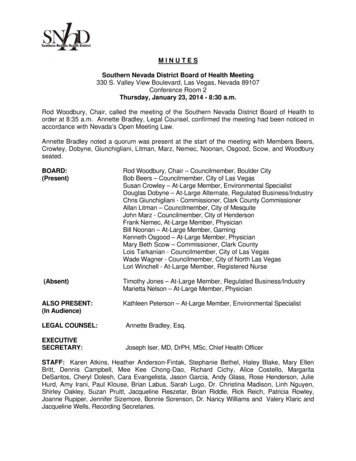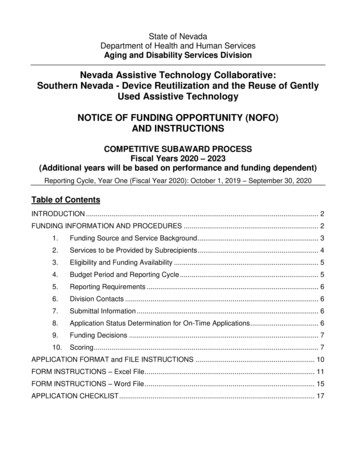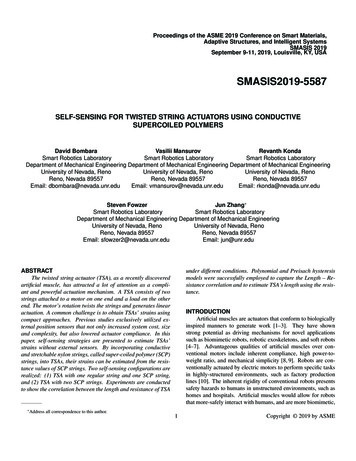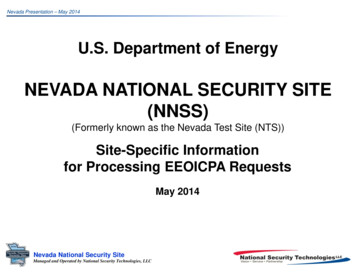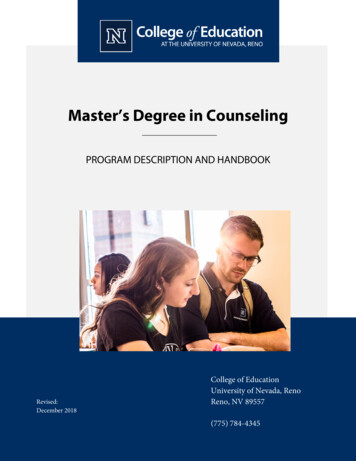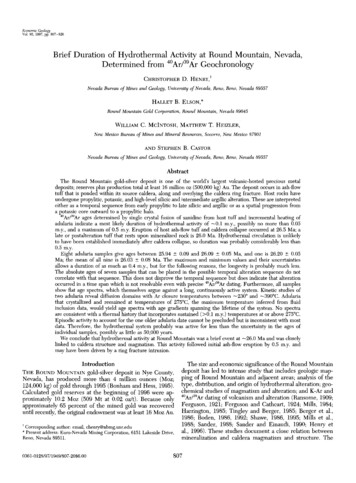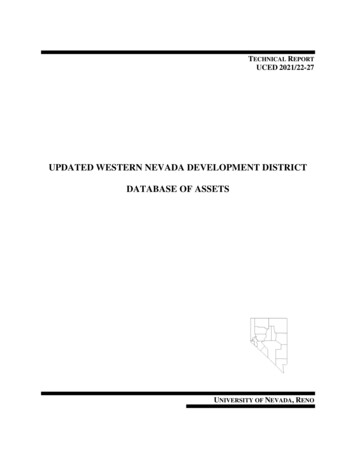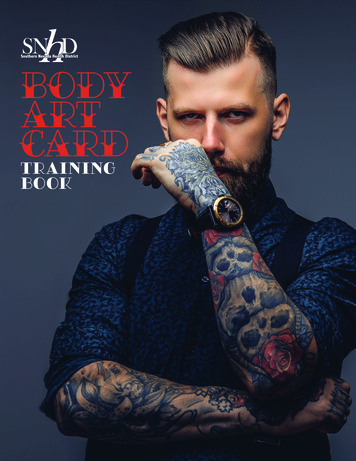
Transcription
TRAININGBOOKSOUTHERN NEVADA HEALTH DISTRICT BODY ART CARD TRAINING BOOKBODYARTCARD1
SOUTHERN NEVADA HEALTH DISTRICT BODY ART CARD TRAINING BOOKIntroductionThe Southern Nevada Health District’s regulations for body art facilities focuson the control of risk factors associated with the practice of body art. Controlof the risk factors will help prevent the spread of disease. Body artists must beknowledgeable about the risk factors so that proper methods are used whenpracticing body art. This booklet contains all the information you need tosuccessfully pass the body art test.While most people think of body art as tattoo and piercing, it can mean many things such asbranding, implants, and scarification. The Health District prohibits placement of implants, branding,or scarification in permitted body art facilities. The Health District only regulates tattooing or piercingin Clark County.2By tattooing the Health District means any method of placing pigment or dye under the skin usingneedles or blades. Piercing is defined as penetrating the skin or a mucous membrane to make apermanent hole. Any business that is providing tattooing or piercing needs a permit. Although, apermit is not necessary if the business limits piercing to only the ear lobe.
Bloodborne pathogens cause diseasewhen blood or other body fluid inan infected person enters the bodyof another who is not infected.Examples of bloodborne pathogensare hepatitis B, hepatitis C, and HIV.Knowing about hepatitis is important to helpprevent the spread of the disease. Hepatitis isan infection of the liver. It is often caused bya virus. In the United States, the three mostcommon types of viral hepatitis are hepatitis A,hepatitis B, and hepatitis C.Hepatitis B virus can be spread throughintimate contact with infected people or byexposure to body fluids such as blood. It cansurvive outside the body on a surface in driedor wet blood for approximately seven days.There are two kinds of hepatitis B. Oneis called acute. This is where a person hassymptoms such as abdominal pain, nausea,vomiting, fever, and jaundice (yellowing ofthe skin). The other is called chronic. This iswhere an infected person does not have anysymptoms but can spread the disease.HIV is another virus that is spread throughcertain body fluids including blood. It attacksthe body’s immune system making it harderfor the body to fight off infections and someother diseases.Since apparently healthy individuals canspread bloodborne pathogens, proper handlingand care in both using and disposing of needlesused in body art will help prevent transmissionof the disease.SOUTHERN NEVADA HEALTH DISTRICT BODY ART CARD TRAINING BOOKBody ArtRisk Factors3
SOUTHERN NEVADA HEALTH DISTRICT BODY ART CARD TRAINING BOOKPROPER HANDWASHINGTECHNIQUEHandwashing is a critical part of personalhygiene and is the first step in preventing thespread of disease. It is important to wash yourhands in a designated handwashing sink beforebeginning to work on a patron. The hand sinkis for hand washing ONLY and should haveliquid soap, paper towels, and a trash can.Handwashing sinks needs to be located ineach cubicle.You need to WASH YOUR HANDS:PP When entering your workspacePP After touching your face, hair, or skinPP After using the restroomPP After you remove glovesPP After taking out the trash or cleaningPP After handling ANYTHING dirtyIn addition to hand hygiene, artists also needto practice good personal hygiene that includesusing hair restraints if hair is over their ears,having clean fingernails, and wearing cleanouter garments.2WET HANDSSOAPwith warm water34RUB VIGOROUSLYRINSEfor 15 seconds56DRYTURN OFF WATERwith paper towelGLOVE USEWASTE DISPOSALIn addition to handwashing, the use ofgloves is important in preventing the spreadof bloodborne pathogens. Since apparentlyhealthy individuals can spread bloodbornepathogens such as hepatitis B and hepatitis C,proper use of disposable gloves will help inpreventing transmission of the disease.Because the hepatitis B virus can surviveoutside the body on a surface in dried or wetblood for approximately seven days, properdisposal of wastes contaminated with blood isimportant in preventing the spread of disease.Any waste that releases liquid blood orother body fluids when compressed or thatmay release dried blood or body fluids whenhandled must be disposed of as biohazardouswaste. This requires that the waste be placedin a red or orange bag with the biohazardouswaste symbol. The waste will then need to bepicked up by a medical waste hauler for properprocessing.Single-use sharps that come in contact withblood or other body fluids (such as needles)need to be properly disposed of after theyIf the gloves you are using become damagedor soiled during a body art procedure, orwhen the procedure is interrupted you:1. must remove the gloves2. dispose of the gloves3. wash your hands4. put on a clean, unused pair of glovesif needed.41
CLEANING EQUIPMENTEquipment that is designed for reuse can beused after the piece of equipment has beenproperly cleaned, packaged, and sterilized ina sterilizer listed with the U.S. Food and DrugAdministration. Sterilizing the equipment willdestroy all forms of microbiotic life such asbacteria and viruses.The packaging must include an indicatorthat signals that the sterilizer reached thecorrect temperature. This indicator may be astrip or words that appear or change when thesterilizing process is complete.After the sterilization is complete, youmust then mark the package with the date ofsterilization.the manufacturer. This will make sure that thesterilizer is working properly.Items that are designed to be used only oncecannot be reused for any reason, and shouldnot be placed in the sterilizer.Disinfectants remove or kill almost all ofthe bacteria and viruses present on a worksurface. Applying a disinfectant is the finalstep in cleaning any work surfaces. Afterany procedure, artists first clean the worksurface. Then, after the work surface hasbeen cleaned, the artist needs to apply adisinfectant registered with the EPA followingthe instructions on the label of the disinfectant.If the instructions are not followed, then thedisinfectant may not remove or kill the germsthat are present. To aid the disinfection process,all work surfaces are required to be durable,easily cleanable and non-absorbent.It is important to practice body art in a placethat will decrease the chance of spreadingillness. If something happens in the shop suchas a loss of water, sewage back-up, or aninfestation of pests, sanitary conditions cannotbe provided. The facility must self-close andcontact the Health District when events likethese happen. The shop must remain closeduntil the problem can be corrected and theHealth District approves reopening.SOUTHERN NEVADA HEALTH DISTRICT BODY ART CARD TRAINING BOOKare used. They cannot be thrown in the trash.Instead they need to be placed into a rigidsealable container that is designed to acceptthe sharps. These containers need to bepicked up by a licensed medical waste haulerfor proper processing. Do not overfill thecontainers or attempt to empty them yourselfas this could result in exposure to disease.IN SUMMARYOnce a sterile pack is opened, the equipmentmust be used immediately, properly disposedof or cleaned, repacked then re-sterilized.All reusable equipment must be used withinsix months of sterilization. If it is not used,then the equipment must be repackaged andsterilized again.Health District regulations require a spore testbe performed on all sterilizing devices at leastone per year or more frequently if required byThe best way to prevent spread of bloodbornedisease is to follow standard precautions,which include:¡¡ Washing your hands before andafter procedures.¡¡ Wearing disposable gloves duringthe procedures.¡¡ Using caution when handling sharps.¡¡ Treat all patrons as potentially infectedwith a bloodborne pathogen, even ifthey deny having one or appear healthy.¡¡ Properly dispose of wastecontaminated with blood.5
SOUTHERN NEVADA HEALTH DISTRICT BODY ART CARD TRAINING BOOKREQUIREDREGULATORY STEPSTATTOOSWhile the design of the art is up to the artists,there are a few things that need to take place tomake sure the application of the art is done in asafe manner.The following are the steps the Health Districtrequires to be taken before and after the art isapplied to the patron.1. The patron completes a consent form thatcontains at a minimum:a. Name and age of patron.b. Address of patron.c. Date, description and location of thetattoo or piercing.d. Artist’s name.e. A statement that the tattoo should beconsidered permanent.f. A statement addressing whether thepatron has a history of jaundice orhepatitis within the last year.Note: These records need to be kept fortwo years and be made available uponrequest by the Health District.2. The patron presents ID. If the patron isunder 21 years of age, then a copy ofthe identification must be kept with theconsent form.3. The area where the art will be applied willneed to be cleansed. If needed, the areasurrounding the location of the art willneed to be shaved using a disposable razorbefore the area is cleansed.4. The art is applied.5. The patron is provided an aftercare sheetand verbal instructions that will help inpreventing complications in the healingprocess. Artists need to use the aftercaresheets approved by the Health District.The instructions provided need to describehow to care for the art, possible sideeffects to be aware of and any restrictionson activities. These sheets also need toinclude a statement about reporting anycomplications to the Health District.If the artist becomes aware that applicationof the art may have caused an infection, theyare required to report that to the Health Districtwithin 48 hours by phone and in writing.PIERCINGAny jewelry used in piercing must be free ofnicks, scratches or irregular surfaces; and bemade of a metal that is either surgical gradestainless steel, 14k or 18k gold, Niobium,titanium or platinum.6
Can something happen thatrequires you to close-up shopimmediately? YES!A few examples of when you should stoppracticing body art include the following:¡¡ Not able to dispose of biohazardouswaste or potentially biohazardous waste.¡¡ Sewage backing up from drains, sinks, ortoilets, and flowing onto the floor of thefacility.¡¡ Lack of sterile needles, tubes, or otherparts of equipment that comes in contactwith pigment or breaks the skin.¡¡ Substantial damage to the buildingbecause of flood, rain, or earthquake.¡¡ A lack of power or water for a periodexceeding two hours.SOUTHERN NEVADA HEALTH DISTRICT BODY ART CARD TRAINING BOOKSubstantialHealthHazardsPlease refer to the body art regulations for alist of all the possible occasions when a bodyart studio should close.Any part of the facility that is affected by thesubstantial health hazard must be closed.If you do close because of a substantial healthhazards please call (702) 759-0677 or send ane-mail to bodyart@snhd.org.7
SOUTHERN NEVADA HEALTH DISTRICT BODY ART CARD TRAINING BOOKPermittingBODY ART CARDSHEALTH PERMITSyou need to apply for a separate special eventpermit. Call (702) 759-0677 or send an e-mailto bodyart@snhd.org to ask for an application.Applications for special events must be receivedat least 30 days before the event.Permits can also be revoked. If Health Districtinspectors observe serious or repeated violationsthe permit can be revoked. The health permitcan also be suspended if there is interferencefrom the artist or permit holder while theinspector conducts an inspection. For moredetails on the permit revocation process pleasereview section 14.5 of the Tattoo Regulations.Any place of business that practices body artmust have a health permit. Body artists arenot allowed to perform body art proceduresoutside of a permitted body art establishment.All permit holders must post in public viewthe health permit to operate along with adisclosure statement approved and supplied bythe Health District.Permits cannot be transferred to anotherlocation or used when working at a tattooconvention. If you move, you must contact theHealth District at (702) 759-1258 to discusswhat is necessary to obtain a permit for the newlocation. If you wish to work at a tattoo show,The person who holds the permit isresponsible for:¡¡ Ensuring all the artists in the shop have validHealth District Body Art Cards¡¡ Making sure that all the applicable permits,licenses, and body art cards that are requiredto be visible to the patrons and the public aredisplayed¡¡ Making sure that the shop meets the requirements of the State of Nevada Occupationaland Health Standards for General Industry (29CFR Part 1910.1030) regarding exposure tobloodborne pathogens.To practice body art in Clark County, all bodyartists must have a valid Southern NevadaHealth District Body Art Card or ApprenticeBody Art Card. You can review the steps andget the necessary paperwork on the HealthDistrict’s website at www.snhd.info/bodyart.Anytime that a body artist is practicing, theymust have, in their possession, a valid HealthDistrict Body Art Card. These cards cannot beshared between two artists.You, the artist, are responsible toensure that you practice body art in amanner that does not spread disease.8If you have any questions, you cancall (702) 759-0677 or send ane-mail to bodyart@snhd.org.www.SNHD.info/bodyart
BODY ART CARD TRAINING BOOK 4 1 WET HANDS with warm water 2 SOAP 3 RUB VIGOROUSLY for 15 seconds 4 RINSE 5 DRY 6 TURN OFF WATER with paper towel PROPER HANDWASHING TECHNIQUE Handwashing is a critical part of personal hygiene and is the first step in preventing the spread of disease. It is important to wash your hands in a designated handwashing .
